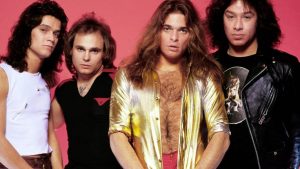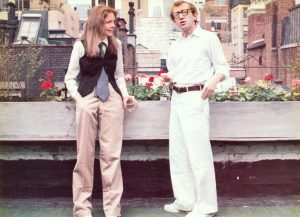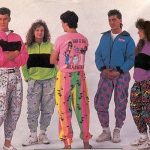
Masayoshi Sukita. “David Bowie as Aladdin Sane.” Digital image. New York Times. January 11, 2016. https://www.nytimes.com/slideshow/2016/01/11/t-magazine/david-bowie-style/s/11tmag-bowie-slide-AQQN.html.
The 1980’s.
A decade where big hair reigned, shoulder pads made everybody into squares, and David Bowie made everybody question their sexuality just a tiny bit.
The launch of the MTV network on August 1st, 1981 sparked a wave of fashion revolution all across the nation as legions of teenagers, male and female, experimented with their clothing choices and gender identities.
Or did they?
Popular culture set during the course of the 1980s presents audiences with a particular interpretation of how citizens crafted their fashion aesthetic: giant hair held up with fire hazard levels of hairspray, shoulder pads so square that they qualify as built in shelving units, and color clashing so garish that most t-shirts could be mistaken for modern art.
- Masulse. Digital image. Best Hairstyles 2018. November 27, 2017. Accessed April 9, 2018. https://besthairstyle2018.com/1980s-hairstyle-photos-intended-for-property/1980s-hairstyle-photos-1980-hairstyles-for-women/.
- Cummins2667. “Alexis Carrington, Dynasty 1980s.” Digital image. Pinterest. March 17, 2018. Accessed April 9, 2018. https://www.pinterest.com/pin/292171094552773127/.
- Deleon, Jian. “1980s, Colors and Patterns.” Digital image. Complex. January 1, 2018. Accessed April 9, 2018. http://www.complex.com/style/the-greatest-80s-fashion-trends/male-ponytails.
In reality, the fashion choices of young adults during this time may not have been as unique as we have been led to believe.
Looking at Mary Washington College (now called the University of Mary Washington) during this time, we find that the everyday fashion aesthetic of this time was not much different than that of the 1990’s or early 2000’s: simple jeans and simple shirts.
What had changed during this decade was an increase in the mainstream entertainment value of experimental performative fashion styles.

“Van Halen.” Digital image. BBC. Accessed April 9, 2018. https://www.bbc.co.uk/music/artists/b665b768-0d83-4363-950c-31ed39317c15.
-Males comfortably adopted certain feminine aspects into their fashion identity as they began idolizing various Hair Band performers such as KISS, Van Halen, or Guns n Roses.

Singer, Leigh. “Annie Hall.” Digital image. British Film Institute. April 20, 2017. Accessed April 9, 2018. http://www.bfi.org.uk/news-opinion/news-bfi/features/five-reasons-annie-hall-woody-allen.
-Females meanwhile could adopt more masculine aspects of fashion as feminist gender identity was redefined to incorporate a more ambitious professional sphere (in previous generations, corporate professionalism was associated with masculinity)
The purpose of this project was to examine how popular culture and fashion intersected during the 1980s. Furthermore; questions of how this popular culture affected gender identity in fashion as we looked at gendered fashion that blurred the lines of masculinity and femininity into a more androgynous style.


